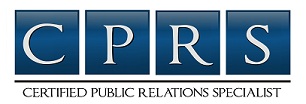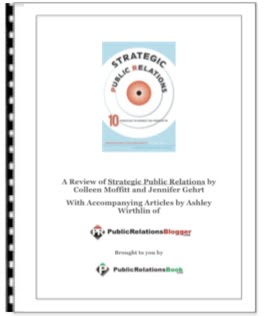________________________________________________________________________
 Without a solid, well-designed foundation, few buildings
Without a solid, well-designed foundation, few buildings
successfully withstand the ravages of time and weather.
And so it is with public relations, ever-dependent upon
how well its practitioners understand the discipline.
Yet, some public relations people manage to go through
their entire career without a firm grasp of what public
relations is all about. Their response to crises, or to
requests for well thought-out solutions to public relations
problems, reveals a serious lack of understanding. They
confuse the basic function of public relations with any
number of tactical parts that make up the whole, such as
publicity, crisis management or employee relations.
Understandably, they feel unsure in approaching public
relations problems, then uncertain about what counsel to
give their clients. Many, relying on career-long
misconceptions about public relations, forge ahead anyway
advising the client ineffectively sometimes with damaging,
if not dangerous counsel.
If you are new to the business, grasp early-on The Rosetta
Stone of public relations, i.e., a guide to understanding the
discipline and its core strength. Namely, people act on their
perception of the facts; those perceptions lead to certain
behaviors; and something can be done about those perceptions
and behaviors that lead to achieving an organization's
objectives.
The fact is that NO organization -- business, non-profit,
association or public sector -- can succeed today unless the
behaviors of its most important audiences are in-sync with the
organization's objectives. Which is why, when public relations
goes on to successfully create, change or reinforce public
opinion by reaching, persuading and moving-to-desired action
those people whose behaviors affect the organization, it
accomplishes its mission.
By all means discuss public relations' strategic role in any
organization with professionals whom you respect. But do it
early, do it seriously, and do it now so that you create that
solid foundation of understanding about this business that will
help you make a meaningful contribution to the field of public
relations for many years to come.
Once that foundation of understanding is firmly set, an action
pathway begins to appear:
-- identify the problem or challenge
-- identify target audiences
-- set the public relations goal
-- set the public relations strategy
-- prepare persuasive messages
-- select/implement key communications tactics
-- monitor progress
-- and the end game? Meet the behavior modification goal.
A bonus: you are using a near-perfect public relations
performance measurement. I mean how can you measure
the results of an activity more accurately than when you
clearly achieve the goal you set at the beginning of that
activity? You can't. It's pure success.
So, if you are a newcomer to the business, can you expect to
avoid the pitfalls listed above? Yes, and here's why:
-- With proper preparation, you will not confuse action tactics
with the basic mission of public relations because you will
know precisely what each is and just what fits where in the
public relations problem solving sequence outlined above.
-- You will feel more confident about providing counsel to the
employer/client because the public relations problem at hand
can be clearly identified allowing you to select solutions that
obviously fit into the action sequence above. You will
accurately identify your target audiences because you will
know exactly who your employer/client wants to reach, and
the necessary action tactics will then be self-evident.
-- You realize that you have gone through your entire career
WITH a firm, successful grasp of what public relations is
all about.
But, on the way you must do everything necessary to reach
your target audiences, and to nurture the relationships between
those audiences and the employer/client by burnishing the
reputation of the organization, its products or services. You'll
do your best to persuade those audiences to do what the
client/employer wishes them to do. And, while seeking public
understanding and acceptance of your client/employer, you'll
insure that your joint activities not only comply with the law,
but clearly serve the public interest. Then, you will pull-out
all tactical stops to actually move those target individuals to
action. Your client will be pleased that you have brought
matters to this point.
When that client measures your real effectiveness, I suggest
that he or she will be fully satisfied with those public relations
results only when your "reach, persuade and move-to-desired
action" efforts produce a visible, and desired, modification in
the behaviors of those people your client/employer wishes to
influence. In my view, this is the central, strategic function of
public relations and the basic context in which you must pursue
that successful public relations career, a lesson best learned at
the beginning of your career.
Robert A. Kelly © 2005.
Bob Kelly counsels, writes and speaks to business, non-profit and association managers about using the fundamental premise of public relations to achieve their operating objectives. He has been DPR, Pepsi-Cola Co.; AGM-PR, Texaco Inc.; VP-PR, Olin Corp.; VP-PR, Newport News Shipbuilding & Drydock Co.; director of communications, U.S. Department of the Interior, and deputy assistant press secretary, The White House. He holds a bachelor of science degree from Columbia University, major in public relations.
Visit his website here.
Article Source.
Tags: public relations tips, successful public relations career, public relations career, public relations
Tips for a Successful Public Relations Career
________________________________________
 Without a solid, well-designed foundation, few buildings
Without a solid, well-designed foundation, few buildingssuccessfully withstand the ravages of time and weather.
And so it is with public relations, ever-dependent upon
how well its practitioners understand the discipline.
Yet, some public relations people manage to go through
their entire career without a firm grasp of what public
relations is all about. Their response to crises, or to
requests for well thought-out solutions to public relations
problems, reveals a serious lack of understanding. They
confuse the basic function of public relations with any
number of tactical parts that make up the whole, such as
publicity, crisis management or employee relations.
Understandably, they feel unsure in approaching public
relations problems, then uncertain about what counsel to
give their clients. Many, relying on career-long
misconceptions about public relations, forge ahead anyway
advising the client ineffectively sometimes with damaging,
if not dangerous counsel.
If you are new to the business, grasp early-on The Rosetta
Stone of public relations, i.e., a guide to understanding the
discipline and its core strength. Namely, people act on their
perception of the facts; those perceptions lead to certain
behaviors; and something can be done about those perceptions
and behaviors that lead to achieving an organization's
objectives.
The fact is that NO organization -- business, non-profit,
association or public sector -- can succeed today unless the
behaviors of its most important audiences are in-sync with the
organization's objectives. Which is why, when public relations
goes on to successfully create, change or reinforce public
opinion by reaching, persuading and moving-to-desired action
those people whose behaviors affect the organization, it
accomplishes its mission.
By all means discuss public relations' strategic role in any
organization with professionals whom you respect. But do it
early, do it seriously, and do it now so that you create that
solid foundation of understanding about this business that will
help you make a meaningful contribution to the field of public
relations for many years to come.
Once that foundation of understanding is firmly set, an action
pathway begins to appear:
-- identify the problem or challenge
-- identify target audiences
-- set the public relations goal
-- set the public relations strategy
-- prepare persuasive messages
-- select/implement key communications tactics
-- monitor progress
-- and the end game? Meet the behavior modification goal.
A bonus: you are using a near-perfect public relations
performance measurement. I mean how can you measure
the results of an activity more accurately than when you
clearly achieve the goal you set at the beginning of that
activity? You can't. It's pure success.
So, if you are a newcomer to the business, can you expect to
avoid the pitfalls listed above? Yes, and here's why:
-- With proper preparation, you will not confuse action tactics
with the basic mission of public relations because you will
know precisely what each is and just what fits where in the
public relations problem solving sequence outlined above.
-- You will feel more confident about providing counsel to the
employer/client because the public relations problem at hand
can be clearly identified allowing you to select solutions that
obviously fit into the action sequence above. You will
accurately identify your target audiences because you will
know exactly who your employer/client wants to reach, and
the necessary action tactics will then be self-evident.
-- You realize that you have gone through your entire career
WITH a firm, successful grasp of what public relations is
all about.
But, on the way you must do everything necessary to reach
your target audiences, and to nurture the relationships between
those audiences and the employer/client by burnishing the
reputation of the organization, its products or services. You'll
do your best to persuade those audiences to do what the
client/employer wishes them to do. And, while seeking public
understanding and acceptance of your client/employer, you'll
insure that your joint activities not only comply with the law,
but clearly serve the public interest. Then, you will pull-out
all tactical stops to actually move those target individuals to
action. Your client will be pleased that you have brought
matters to this point.
When that client measures your real effectiveness, I suggest
that he or she will be fully satisfied with those public relations
results only when your "reach, persuade and move-to-desired
action" efforts produce a visible, and desired, modification in
the behaviors of those people your client/employer wishes to
influence. In my view, this is the central, strategic function of
public relations and the basic context in which you must pursue
that successful public relations career, a lesson best learned at
the beginning of your career.
Robert A. Kelly © 2005.
Bob Kelly counsels, writes and speaks to business, non-profit and association managers about using the fundamental premise of public relations to achieve their operating objectives. He has been DPR, Pepsi-Cola Co.; AGM-PR, Texaco Inc.; VP-PR, Olin Corp.; VP-PR, Newport News Shipbuilding & Drydock Co.; director of communications, U.S. Department of the Interior, and deputy assistant press secretary, The White House. He holds a bachelor of science degree from Columbia University, major in public relations.
Visit his website here.
Article Source.
Tags: public relations tips, successful public relations career, public relations career, public relations
Popular choices
- Non Gamstop Casino
- Mejores Salas De Póker
- Non Gamstop Casinos
- Siti Casino Online Non Aams
- Migliori Siti Casino Online
- UK Online Casinos Not On Gamstop
- Non Gamstop Casino Sites UK
- Non Gamstop Casino Sites UK
- UK Casino Not On Gamstop
- Casinos Not On Gamstop
- Online Casino
- オンラインカジノ
- UK Casino Not On Gamstop
- UK Casino Not On Gamstop
- Reputable Non Gamstop Casinos
- Casinos Not On Gamstop
- Best Non Gamstop Casinos
- Non Gamstop Casino
- Casinos Not On Gamstop
- Slots Not On Gamstop
Subscribe to:
Post Comments (Atom)






Comments (0)
Post a Comment